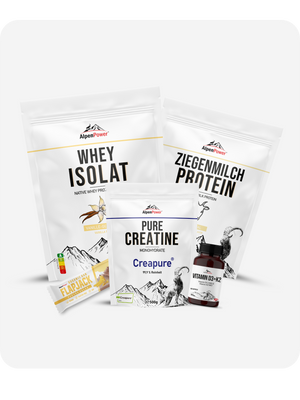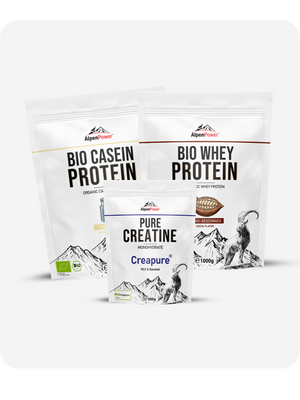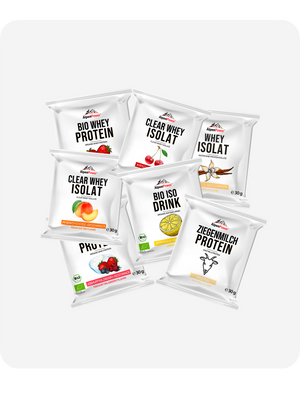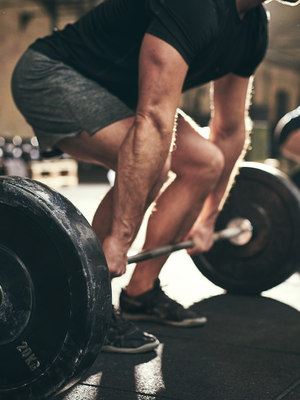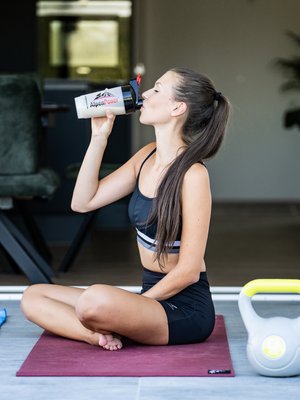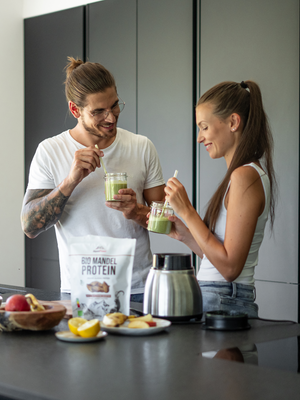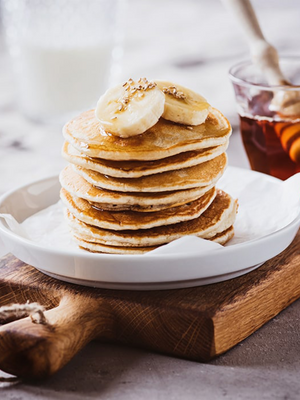Breakfast like an emperor, lunch like a king and dinner like a beggar: I'm sure everyone knows this saying. But while many people don't leave the house without a hearty breakfast, others are satisfied with a quick coffee and prefer to skip breakfast. There are many variations: no breakfast, quick or hearty breakfast, late breakfast, sweet or savory - but which one is right?
Breakfast - breaking the fast
Breakfast in the morning ends the night's fasting and provides the body with energy and important nutrients for the day. A portion of protein in combination with high-fiber carbohydrate sources, plus some fat and vitamins from fruit or vegetables - that's the basics of an optimal breakfast. As simple as it may sound in theory, many people find it difficult to implement in everyday life. here are the three most common breakfast mistakes and reasons why you may often suffer from cravings during the day. Plus: your breakfast kit for a balanced breakfast.
Mistake #1: Not eating breakfast
We've all been there: the alarm clock rings, you press the snooze button once more and go back to sleep - and ten valuable minutes have already been wasted. When work, university or school calls in the morning, there is often no time for breakfast. Sipping a quick coffee and checking the news on social media in the meantime has become a morning routine for many. Many don't even think about having breakfast, let alone taking something with them, and are then surprised when cravings become a daily companion. But it's precisely in the morning - or mid-morning - that you should replenish your energy stores to have enough power for the day. If you skip the first meal of the day - perhaps in the hope of saving calories and losing weight - you will probably get the energy you saved back at the next meal, i.e. lunch. Logically, your hunger will be huge by then and your body will be craving quick energy - and you may eat far too quickly.
Tip #1: Plan your first meal of the day in the morning or mid-morning.
Therefore, try to plan 15 to 20 minutes for breakfast in your morning routine. If you can't get anything down in the morning, that's completely okay - don't force yourself to do it. In this case, take your breakfast with you from home, such as these delicious high-protein overnight oats to go. Pay attention to when you get hungry and eat your first meal then. But you don't have time to enjoy your breakfast in the morning because you're at work, university or school? No problem, just drink it! A homemade breakfast shake is also easy to drink in between meals and gives you the energy boost you need. Try this recovery shake or hemp protein peanut banana smoothie.
Mistake #2: Breakfast too sweet
A quick jam sandwich, a coffee with a dash of milk and the classic Austrian breakfast is ready. Although the jam sandwich provides a quick energy boost so that you can easily dance up the stairs to the office in the morning, you'll notice after an hour or two at the latest: Something is missing... That's right, energy! This is what happens in your body: if you start the day with a lot of sugar, your blood sugar level quickly skyrockets. In order to transport the sugar from the blood into the cells, your pancreas produces insulin - a lot at once. It unlocks your cells like a key. The blood sugar in your blood drops again like a rollercoaster ride. And you can feel it: If you start thinking about chocolate at ten o'clock or have difficulty concentrating in the morning. Then it could simply be because your blood sugar has been on a rollercoaster ride and your body is screaming: "Again, again!" But what your body doesn't know is that this rollercoaster ride isn't so great in the long run. The constant fluctuations in blood sugar can lead to recurring cravings and put a strain on our metabolism.
Tip #2: Make sure your breakfast is a combination of protein, high-fiber carbohydrates and a vitamin and fat component.
| Source of protein | High-fiber carbohydrates | Vitamins | Fat component |
|---|---|---|---|
|
Skimmed natural dairy products, |
Cereal flakes, e.g. oat, spelt, five-grain flakes |
Seasonal and regional fruit or vegetables |
Nuts, e.g. walnuts, hazelnuts |
| Egg | Wholemeal semolina, millet, buckwheat, quinoa, rice, oat powder | Sprouts, cress |
Seeds, e.g. linseed, hemp seed |
|
Pulses, |
Wholemeal bread or cookies, wholemeal crispbread | Herbs |
Nut butter, e.g. almond butter, peanut butter |
| Plant-based milk substitute products, e.g. soy or pea drink, soy yogurt |
Puffed natural cereals, |
Vegetable oils, e.g. linseed oil, walnut oil | |
| Whey protein or plant-based proteins |
You can then spice up your breakfast with flavored ingredients such as butter, jam, honey, protein cream or crunchy muesli. However, these ingredients should only provide the icing on the cake and not be the main ingredient.
Mistake #3: Eating a low-protein breakfast
Wondering why everyone raves about porridge and overnight oats, but you never stay full for long? Maybe it's because you only cook the oats in water, oat, rice or almond drink and you're missing out on a good portion of protein. Protein is an important nutrient for cell renewal, muscle building and the immune system and can also improve our satiety. Especially in the morning, when you have a long day ahead of you, you shouldn't miss out on this key nutrient. However, give preference to high-quality sources of protein and try to avoid meat in the form of sausage or ham.
Tip #3: Increase the satiety effect of your breakfast with a protein portion.
It is therefore better to prepare your oatmeal with soy or pea drink or add skyr, yoghurt, curd cheese, whey protein or plant-based protein powder after cooking. A spoonful of almond butter or protein cream and a handful of fresh, seasonal fruit round off the taste.
Conclusion
Author: Birgit Kogler BSc, dietician: https://www.ernaehrungsberatung-kogler.at/ Info: Would you like professional advice on sports nutrition to help you adapt your diet to your training? You can find a sports dietician near you at www.diaetologen.at/suche.
Sources: Hahn, A, Ströhle, A., Wolters, M., Behrendt, I. & Heinen, D. (2016). Nutrition. Physiological principles, prevention, therapy (3rd ed.). Stuttgart: Wissenschaftliche Verlagsgesellschaft. Hausbrot.at (2016) Breakfast Report 2016 - How Austria eats breakfast. Online on the WWW at: https://www.marktmeinungmensch.at/studien/fruehstuecksreport-2016-so-fruehstueckt-oesterreic/ (last accessed on: 20.8.2022) Höfler, E. & Sprengart, P. (2012). Practical dietetics. Fundamentals, goals and implementation of nutrition therapy ; with 205 tables (Textbook, 1st ed.). Stuttgart: WVG Wiss. Verl.-Ges. Laska, M., Hearst, M., Lust, K., Lytle, L., & Story, M. (2015). How we eat what we eat: Identifying meal routines and practices most strongly associated with healthy and unhealthy dietary factors among young adults. Public Health Nutrition, 18(12), 2135-2145. doi:10.1017/S1368980014002717 Ogden, J., Oikonomou, E., Alemany, G. (2017) Distraction, restrained eating and disinhibition: An experimental study of food intake and the impact of 'eating on the go. Journal of Health Psychology. 2017;22(1):39-50. doi:10.1177/1359105315595119 Rania A Mekary, Breakfast Skipping and Type 2 Diabetes: Where Do We Stand?, The Journal of Nutrition, Volume 149, Issue 1, January 2019, Pages 1-3, https://doi.org/10.1093/jn/nxy284 Renner B. (2015) Ernährungsverhalten 2.0. In: Ernährungs Umschau 1/2015. M37-M46. Richter J et al. (2020) Twice as high diet-induced thermogenesis after breakfast vs dinner on high-calorie as well as low-calorie meals. J Clin Endocrinol Metab 105(3): 1-11. Zeratsky K (2014) Why does eating a healthy breakfast help control weight? Available from: http://www.mayoclinic.org/food-and-nutrition/expert-answers/FAQ-20058449 .
